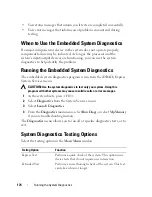
Troubleshooting Your System
159
• Power supplies
• Processor and heat sink
• Memory modules
• Fan bracket
4
Let the system dry thoroughly for at least 24 hours.
5
Reinstall the processor and heat sink, memory modules, power supplies,
cooling shroud, and fan bracket.
6
Close the system. See "Closing the System" on page 83.
7
Reconnect the system to the electrical outlet, and turn on the system.
If the system does not start properly, see "Getting Help" on page 189.
8
If the system starts properly, shut down the system and reinstall the rest of
the components that you removed in step 3. See "Installing an Expansion
Card" on page 121.
9
Run the appropriate online diagnostic test. See "Using Online Diagnostics"
on page 173.
If the tests fail, see "Getting Help" on page 189.
Troubleshooting a Damaged System
CAUTION:
Many repairs may only be done by a certified service technician.
You should only perform troubleshooting and simple repairs as authorized in
your product documentation, or as directed by the online or telephone service
and support team. Damage due to servicing that is not authorized by Dell is not
covered by your warranty. Read and follow the safety instructions that came
with the product.
1
Turn off the system and attached peripherals, and disconnect the system
from the electrical outlet.
2
Open the system. See "Opening the System" on page 83.
3
Ensure that the following components are properly installed:
• Expansion cards and both expansion-card risers
• Power supplies
• Fans and cooling shroud
• Processor and heat sink
Summary of Contents for DX6000
Page 1: ...Dell DX6000 Systems Hardware Owner s Manual ...
Page 78: ...78 Using the System Setup Program and UEFI Boot Manager ...
Page 154: ...154 Installing System Components ...
Page 188: ...188 Jumpers and Connectors ...
Page 190: ...190 Getting Help ...
Page 198: ...202 Index ...
















































